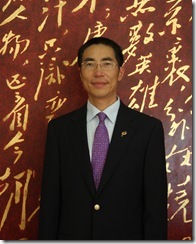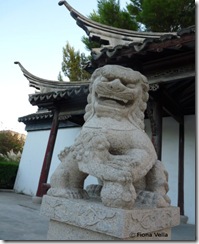Archive for the ‘Malta Independent on Sunday – First magazine’ Category
-
Free weekly acupuncture treatments in Gozo
Since 1994, several Chinese medical teams have been offering medical treatments to the Maltese public from the Mediterranean Regional Centre for Traditional Chinese Medicine in Kordin. This professional service extends also at Mater Dei Hospital and at Gozo General Hospital.
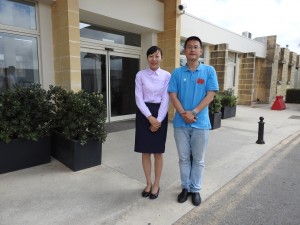 I accompanied Dr Xiao Ming Yang and Ms Wei Han on their weekly visit to Gozo General Hospital.
I accompanied Dr Xiao Ming Yang and Ms Wei Han on their weekly visit to Gozo General Hospital.“Every Wednesday afternoon, I treat an average of 24 patients with acupuncture. Many of the patients book the treatment at the hospital, however I do not mind treating also those individuals who happen to come by,” explained Dr Yang.
Dr Yang and Ms Han’s dedication to their work is impeccable. They take the responsibility to carry with them all the required material from Malta to Gozo. From time to time, they also provide the patients with bonus treatments to take home with them.
“Acupuncture treatments are provided free of charge according to an agreement which was done between the Maltese and the Chinese governments. This is a way of showing the mutual respect which exists between the two countries.”
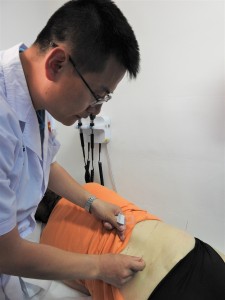 Around 30 patients were waiting for Dr Yang at Gozo General Hospital. The relationship between the Chinese doctor and his Gozitan patients was clearly amicable as he went round each patient and applied the required acupuncture treatment.
Around 30 patients were waiting for Dr Yang at Gozo General Hospital. The relationship between the Chinese doctor and his Gozitan patients was clearly amicable as he went round each patient and applied the required acupuncture treatment.The popularity of this treatment is definitely pushing for more adequate space in order to provide this service to all those who need it. For a more effective benefit of this Chinese traditional therapy, several patients have also expressed their wish to increase the frequency of the doctor’s visit to at least twice a week.
After the acupuncture treatment, Ms Han, the Chinese interpreter at the Centre, prepared five different herbal teasfor those who attended. She also shared interesting information about the benefits of these teas.
“Chinese herbal teas have been used for centuries to provide healthy refreshment. Drinking herbal teas is a natural and effective way to gain various health benefits. Each tea can have one ingredient or many with different benefits,” revealed Ms Han.
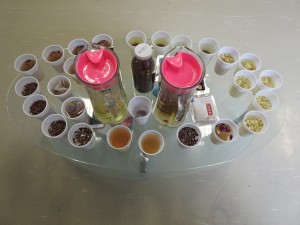 “Jasmine tea is one of the most popular flower teas among foreigners because of its pleasant scent and taste. In ancient times in China, this tea was mainly reserved for royalty since it has so many health benefits. The high level of antioxidants in the tea help to boost the body metabolism making exercise more effective. This may result in weight loss and in improvement in the digestive process. Moreover, for those with cardiovascular problems, jasmine tea can be a huge help as it aids to lower cholesterol levels and high blood pressure, thereby reducing the risk of heart attacks and maintaining a healthy cardiovascular system. This tea is also ideal for people suffering from chronic discomfort, such as back pain, joint pain and arthritis, because it has anti-inflammatory properties which can help reduce swelling and inflammation of joints.”
“Jasmine tea is one of the most popular flower teas among foreigners because of its pleasant scent and taste. In ancient times in China, this tea was mainly reserved for royalty since it has so many health benefits. The high level of antioxidants in the tea help to boost the body metabolism making exercise more effective. This may result in weight loss and in improvement in the digestive process. Moreover, for those with cardiovascular problems, jasmine tea can be a huge help as it aids to lower cholesterol levels and high blood pressure, thereby reducing the risk of heart attacks and maintaining a healthy cardiovascular system. This tea is also ideal for people suffering from chronic discomfort, such as back pain, joint pain and arthritis, because it has anti-inflammatory properties which can help reduce swelling and inflammation of joints.”“Rose tea is used to relieve menstrual discomfort or heavy period. It can also regulate the sleep cycle and pattern. For those who suffer from insomnia or have disturbed sleep, drinking rose tea before going to bed might be a great option. Rose tea can also improve digestion, detoxify the body, and relieve respiratory infections.”
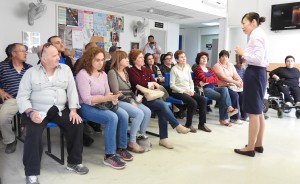 “Buckwheat tea is a kind of grain tea and it can reduce blood glucose and cholesterol. It really has significant cardiovascular benefits and helps to lose weight.”
“Buckwheat tea is a kind of grain tea and it can reduce blood glucose and cholesterol. It really has significant cardiovascular benefits and helps to lose weight.”“Rhodiola tea is made of dry flowers, leaves and roots of a wild plant called Rhodiola Rosea, which grows best in the high, cold mountains, such as Tibet, Siberia and Arctic areas.It has good effects on anti-aging and longevity.In ancient times, Chinese emperors used to send expeditions to remote areasin search of this golden root to make pills of immortality. This tea can also protect human cells especially skin cells from aging, so a lot of beauty products use it as one of their ingredients.”
“Jujube is a kind of sour date. Thanks to its special healing properties relating to insomnia, it is regarded as the “Oriental sleeping fruit.”Jujube seed tea can calm the mind and smooth the nerves. Therefore, it is often used to treat insomnia, nightmares, night sweats, restless sleep and neurasthenia.”
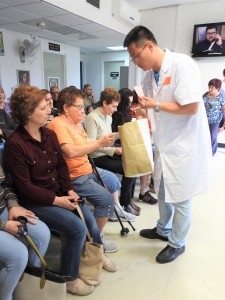 At the end of this meeting, participants were also provided with a packet of tiger balm, green oil and plasters. Tiger balm has been in use in China from the 1870s and it serves to relieve back pain, joint pain, stiffness, sprains, arthritis, headaches, sinus congestion, and discomfort from mosquito bites. Green oil has the same effect as tiger balm. Plasters are mainly used to relieve back pains, joint pains, arthritis, chronic sprain, and rheumatism.
At the end of this meeting, participants were also provided with a packet of tiger balm, green oil and plasters. Tiger balm has been in use in China from the 1870s and it serves to relieve back pain, joint pain, stiffness, sprains, arthritis, headaches, sinus congestion, and discomfort from mosquito bites. Green oil has the same effect as tiger balm. Plasters are mainly used to relieve back pains, joint pains, arthritis, chronic sprain, and rheumatism.For more information, one can contact the Mediterranean Regional Centre for Traditional Chinese Medicine in Kordin on 2169 1799 or the Gozo General Hospital on 2210 6000.
(This article was published in The Malta Independent on Sunday on 5 June 2018)
-
Visions of China
Travellers and explorers have always fascinated me since I tend to feel enticed by the unknown and the unusual. Their experiences have urged me to make my own discoveries in this overwhelmingly disparate planet that is made up of a multitude of different cultures, beliefs and traditions. Interestingly, such exciting revelations can be just a step away, as my meeting with Gu Hongxing, Director at the China Cultural Centre in Malta, confirmed.
A brief walk along the old Maltese houses in Melita Street, Valletta instilled in me a strong feeling of traditional local culture and architecture. Yet intriguingly, one particular huge door lead to a compellingly contrasting experience: a portal into the alluring world of China. Once inside, my eyes absorbed the distinctive Chinese furnishings that were splendidly chosen to merge elegantly with the Maltese building structure. Likewise, when warmly greeted by Gu Hongxing, I realized that such a refined blending could also definitely take place between the peoples of both countries.
The China Cultural Centre was established in Malta in 2003 with the aim of promoting and enhancing cultural exchange and cooperation between Malta and China. Along the years, it has provided a variety of training courses and organized many cultural activities in order to nourish mutual understanding and friendship among the two countries. In fact by now, a good number of Maltese have become members of this cultural centre and have therefore enjoyed the benefits of cultural exchange activities.
Further knowledge about China is stimulated through the extensive library which boasts a selection of over 11,000 books, newspapers and periodicals, as well as electronic materials in both Chinese and English, most of which are available for circulation. The books generally cover a vast range of subjects such as China’s politics, economy, culture, history, geography, religion, natural environment, and science. Other books relate to masterpieces on Chinese and foreign literature, drama, dance, fine art, photography, films and television. Similarly, the electronic reading materials include editions on China’s economic development, places of interest, folk custom, culture, religion, music pieces of traditional music, films and TV series.
This cultural centre is also equipped with a comfortable classroom, a function room and an exhibition hall which are customarily used by its members. During my visit, the function hall was accomodating 25 Maltese students who were attending to a traditional Chinese painting course. The course which lasted three weeks was delivered by a professional Chinese painter from the Hubei Institute of Fine Arts, Xie Xiaohong.
Traditional Chinese painting is one of the oldest artistic traditions in the world that are still in practice. This art is known to aid to quiet the mind and to expand creative self-expression and discipline. During this course, the participants had the opportunity to learn both the theory and the techniques for painting a variety of subjects as well as different styles of paintings, such as line paintings, meticulous paintings and free-sketch paintings. Copies of antique Chinese paintings were distributed among the participants in order to encourage them to imitate them or to get inspired by them. Eventually, each student had to produce at least three new works of art in order to portray the skills that were learnt.
Gu Hongxing was delighted with the thorough interest that was shown by the numerous attendants. Likewise, painter Xie Xiaohong was impressed by the final outcomes of the students. The participants’ work was finally exhibited in the centre’s exhibition hall so that both the members and the public could appreciate the resulting achievements. The course was only intended to deliver a basic knowledge of traditional Chinese painting. However, all the participants that I talked to, perceived that they had received the value of much more.
Claire told me that the students were provided with all the material required such as ink, colours, brushes and rice paper. Although aware that this was a basic course, she felt that they had actually covered a lot of ground. She explained about line paintings and showed me how in Chinese traditional paintings, differing types of lines are used to represent texture, light and shadow.
Astrid was observing a copy of an ancient Chinese painting which had been done by the method of meticulous painting. Intensely focused on coming out with a creation of her own, she described to me the customary use of black ink in such works, whilst she trasmitted soft studied brush strokes on the opaque rice paper in front of her. Indeed, she acknowledged that this course will surely be a strong inspiration to her future paintings.
Mark, a graphic designer by profession, had decided to attend this course together with his girlfriend Andrea. Usually accustomed to perform his artworks by the use of a computer, Mark was curious to explore the possibilities of a different technique. His artworks, clearly identified by a distinct signature, proved that he had succeeded to master the basic skills that he had been taught. Meanwhile, he explained to me in great detail the significance behind Chinese traditional paintings which tend to depict just one concept whilst leaving a void as a background, unlike Western art. He divulged that this is a painting method which allows each viewer to complete the illustration through one’s imagination. For example, the painting of a smoothly sliding fish may instantly create the illusion of a swimming fish thereby permitting the mind to fill in the rest of the scene. Similarly, a fish in a swerving vertical position may give the impression of it being just caught by some lucky fisherman. Both Mark and Andrea agreed that good comprehension of such a foreign art would not have been possible without the theoretical part of the course, during which the students were introduced to the history and development of such methods.
Tamara and Abigail admitted that they are fascinated with the culture of Asia in general because they consider it highly artistic. In fact, they had already participated in another course related to Chinese paper-cutting. They believed that such courses provided the significant opportunity to familiarize themselves with another culture and also to meet artistic professionals from whom they could obtain new skills.
Each month, members are informed about the regularly new activities that are organized by the China Cultural Centre. Some courses, such as the Chinese language courses, include also a fantastic award for the two most excellent students of every scholastic year – a complimentary Award Tour in China that is organized by the Ministry of Culture of China.
I left the centre with the pleasant feelings of accomplishment and discovery. It was admirable how much the people of China were determined to reach out to the Maltese in order to share and exchange both countries’ different ideas, traditions and cultures. Undoubtedly, as Henry Miller once said “One’s destination is never a place, but a new way of seeing things.”
The China Cultural Centre can be reached at 173 Melita Street,Valletta. Further information may be obtained by calling 21225055 or by email cccmal@culturalink.gov.cn or by accessing the website http://malta.cccweb.org/mt/
Courses at the China Cultural Centre in Malta
Course: Chinese martial arts (popularly known as Kung Fu)
Provided by: Master Dong Fuming, a renowned Wudang Martial Arts teacher from China. This course is ideal for those who wish to develop their knowledge of Chinese martial arts and to experience the basic Kung Fu movements. The course will teach participants how to control their body and mind and to perform a set of Wudang Kuangfu forms.
Venue: Mediterranean Regional Centre for Traditional Chinese Medicine, Kordin, Paola.
Application deadline: 15 October 2012
Course duration: 15 October 2012 till 26 October 2012
Time: 18:00 – 20:00, every Monday to Friday
Tuition fees: €50 for China Cultural Centre members and €60 for non-members for a total of 10 sessions
Course: Chinese language class (4 types of courses available: from beginners to advanced)
Application deadline: 19 October 2012-09-18
Course duration: 30 sessions of each level that will extend from the mid of October this year to the mid of June next year.
Time: Depends on which course chosen.
Tuition fees: The fee per year will be €100, plus €12 for adult and €7 for students as an annual membership subscription.
(This article was published in FIRST magazine (October 2012 issue) with The Malta Independent on Sunday)
-
THE SICILIAN CONNECTION – Archaeotur Project
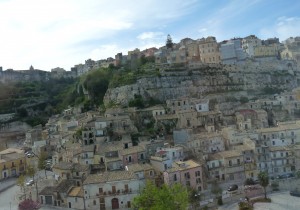 Though many Maltese tend to perceive their archipelago as a solitary group of islands in the centre of the Mediterranean Sea, the nearby island Sicily has always been closely present both geographically and often historically. The Archaeotur project aims to enhance the rediscovery of the archaeological and cultural identities of both islands, particularly by setting up a set of heritage trails which link a number of renowned sites together with other interesting locations that are presently found off the usual beaten tourist track.
Though many Maltese tend to perceive their archipelago as a solitary group of islands in the centre of the Mediterranean Sea, the nearby island Sicily has always been closely present both geographically and often historically. The Archaeotur project aims to enhance the rediscovery of the archaeological and cultural identities of both islands, particularly by setting up a set of heritage trails which link a number of renowned sites together with other interesting locations that are presently found off the usual beaten tourist track.On crisp clear nights, some Sicilians search out for Malta’s twinkling lights across the separating sea known as the channel of Malta. Similarly during a fine limpid day, the area of Mount Etna is distinctly visible from Mdina. One may thus wonder how the ancient populations of these islands might have regarded this ‘nearness’ and what they might have shared. The Archaeotur project focuses on these similarities but also on the differences which vividly portray an affinity but no less a diversity between the two places, thereby enticingly creating a new world to discover just a few kilometres away.
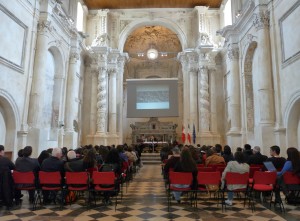 During last April, a group of Maltese experts in archaeology and in cultural tourism, together with a number of local university students, attended a three-day seminar that was held at the Auditorium San Vincenzo Ferreri in Ragusa Ibla. The Maltese and Sicilian counterparts discussed the plans of the Archaeotur project, gave detailed descriptions of some of the concerned archaeological sites and the findings discovered within, and shared information and ideas about what has been done so far and what work still needs to be tackled so that these sites are conserved and presented in the most professional way to all the visitors.
During last April, a group of Maltese experts in archaeology and in cultural tourism, together with a number of local university students, attended a three-day seminar that was held at the Auditorium San Vincenzo Ferreri in Ragusa Ibla. The Maltese and Sicilian counterparts discussed the plans of the Archaeotur project, gave detailed descriptions of some of the concerned archaeological sites and the findings discovered within, and shared information and ideas about what has been done so far and what work still needs to be tackled so that these sites are conserved and presented in the most professional way to all the visitors.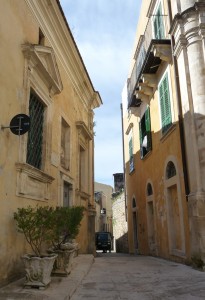 Residing in a small hotel in Ragusa Ibla, the Maltese participants could indulge in the historical aura of the oldest part of this town. Narrow alleys with speeding motorini and compact vans running through them led to some impressive medieval buildings and baroque palaces. Interestingly much of this area had to be rebuilt after a very strong earthquake hit Ragusa on the 11th January 1693, killing about 5000 people and destroying many remarkable buildings such as a castle, palaces, churches, and many houses. After this catastrophe, some survivors in Ragusa wanted to rebuild the destroyed part of the town in the same place whilst others preferred to build their residences in another area, thereby creating two facets of this town which eventually became known as the old and the modern Ragusa. Three bridges which connect the older part to the new part of the town have inspired people to identify Ragusa as the city of bridges. These bridges provide a stunning view of this historical town, its buildings huddled closely together, as if clinging for life to the strong high precipice. In the last years, the old centre has been revived again with the opening of a number of shops, bars, restaurants and hotels. Indeed, Ragusa’s distinguished Sicilian character has attracted many photographers and film producers, the latest of which being the popular Italian TV series of ‘Il Commissario Montalbano’.
Residing in a small hotel in Ragusa Ibla, the Maltese participants could indulge in the historical aura of the oldest part of this town. Narrow alleys with speeding motorini and compact vans running through them led to some impressive medieval buildings and baroque palaces. Interestingly much of this area had to be rebuilt after a very strong earthquake hit Ragusa on the 11th January 1693, killing about 5000 people and destroying many remarkable buildings such as a castle, palaces, churches, and many houses. After this catastrophe, some survivors in Ragusa wanted to rebuild the destroyed part of the town in the same place whilst others preferred to build their residences in another area, thereby creating two facets of this town which eventually became known as the old and the modern Ragusa. Three bridges which connect the older part to the new part of the town have inspired people to identify Ragusa as the city of bridges. These bridges provide a stunning view of this historical town, its buildings huddled closely together, as if clinging for life to the strong high precipice. In the last years, the old centre has been revived again with the opening of a number of shops, bars, restaurants and hotels. Indeed, Ragusa’s distinguished Sicilian character has attracted many photographers and film producers, the latest of which being the popular Italian TV series of ‘Il Commissario Montalbano’.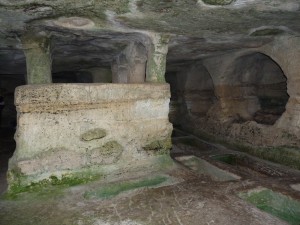 The seminars’ participants were also given the opportunity to visit some of the locations that are included in the Archaeotur project in order to understand better the significance and value of this endeavor. One of the most outstanding was certainly the catacomb of the Grotta delle Trabacche in Ragusa. Recently, this catacomb has been thoroughly cleaned out and conserved, and information posts have been placed in the vicinity in order to guide those visiting this site. Two central opulent and monumental tombs within this catacomb indicate that two individuals who had some importance or a form of authority in their society were buried there. Moreover, one finds several other common tombs that were dug out of the walls and floors of the cavern.
The seminars’ participants were also given the opportunity to visit some of the locations that are included in the Archaeotur project in order to understand better the significance and value of this endeavor. One of the most outstanding was certainly the catacomb of the Grotta delle Trabacche in Ragusa. Recently, this catacomb has been thoroughly cleaned out and conserved, and information posts have been placed in the vicinity in order to guide those visiting this site. Two central opulent and monumental tombs within this catacomb indicate that two individuals who had some importance or a form of authority in their society were buried there. Moreover, one finds several other common tombs that were dug out of the walls and floors of the cavern.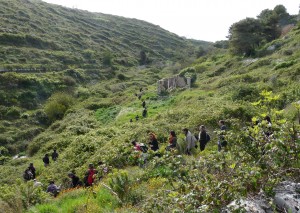 Ironically although hypogea and catacombs are directly connected with death, these sites tend also to provide crucial information about the life and the rituals of the living individuals who used these places. Therefore for example, a multitude of catacombs that are present in Cava Celone might be expressing the situation of an increasing population. These archaeological sites are magnificently enfolded within a wide valley full of wild vegetation, thus endowing the experience of visiting them with a sense of adventure; the silence reigning within the valley allows one to feel truly at one with nature. Meanwhile, the visit to three catacombs in this location revealed the work that still needs to be done on these archaeological sites, including cleaning, conserving, and planning a more practical path which the visitors could use for easy access.
Ironically although hypogea and catacombs are directly connected with death, these sites tend also to provide crucial information about the life and the rituals of the living individuals who used these places. Therefore for example, a multitude of catacombs that are present in Cava Celone might be expressing the situation of an increasing population. These archaeological sites are magnificently enfolded within a wide valley full of wild vegetation, thus endowing the experience of visiting them with a sense of adventure; the silence reigning within the valley allows one to feel truly at one with nature. Meanwhile, the visit to three catacombs in this location revealed the work that still needs to be done on these archaeological sites, including cleaning, conserving, and planning a more practical path which the visitors could use for easy access.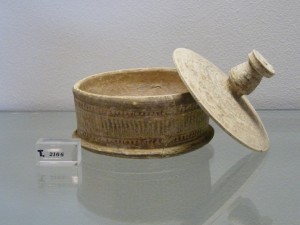 A visit to the Regional Museum of Camarina was undoubtedly distinctive especially because of the extraordinary display of a multitude of findings that were discovered both on land and under the sea of the Santa Croce Camarina area. Many of the artefacts discovered on land pertain to burial rites. Some of them are so refined that it is believed that they belonged to a Greek aristocracy who had immigrated to this area. On the other hand, the numerous objects that were recovered from several wrecks in the bay of Camarina demonstrate that many commercial ships passed through this zone. Among the prestigious exhibits, one finds a bronze archaic helmet that was recovered from a relic that lay seven metres under the sea in front of Punta Braccetto. Several amphorae, a classical Attic-Etruscan helmet, seventy-three clay lamps and some silver items were retrieved from two other relics that were buried in the middle of the bay. Likewise, in 1991, a huge storm revealed the treasure trove of a hoard of 6000 coins that was buried only 200 metres away from the coast.
A visit to the Regional Museum of Camarina was undoubtedly distinctive especially because of the extraordinary display of a multitude of findings that were discovered both on land and under the sea of the Santa Croce Camarina area. Many of the artefacts discovered on land pertain to burial rites. Some of them are so refined that it is believed that they belonged to a Greek aristocracy who had immigrated to this area. On the other hand, the numerous objects that were recovered from several wrecks in the bay of Camarina demonstrate that many commercial ships passed through this zone. Among the prestigious exhibits, one finds a bronze archaic helmet that was recovered from a relic that lay seven metres under the sea in front of Punta Braccetto. Several amphorae, a classical Attic-Etruscan helmet, seventy-three clay lamps and some silver items were retrieved from two other relics that were buried in the middle of the bay. Likewise, in 1991, a huge storm revealed the treasure trove of a hoard of 6000 coins that was buried only 200 metres away from the coast.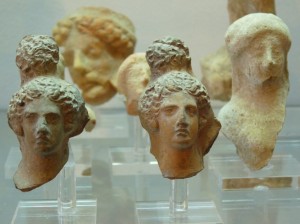 Undeniably, the participants in this seminar had a good taste of the potential of these Sicilian sites that are included in the project of Archaeotur. In the first week of September, a second seminar, this time organized in Malta, will once again reunite Maltese and Sicilian experts and participants so that they can evaluate the work that has been done so far and also to visit some of the Maltese sites which form part of the Archaeotur project.
Undeniably, the participants in this seminar had a good taste of the potential of these Sicilian sites that are included in the project of Archaeotur. In the first week of September, a second seminar, this time organized in Malta, will once again reunite Maltese and Sicilian experts and participants so that they can evaluate the work that has been done so far and also to visit some of the Maltese sites which form part of the Archaeotur project.No doubt this EU project is proving of great benefit towards cross-border cooperation in the sector of heritage conservation and interpretation and no less to cultural tourism which is certainly of substantial benefit to both territories.
Archaeotur is a 1.37 million euro project which is co-financed under the Italia-Malta Programme Cohesion Policy 2007 – 2013 and is part-financed by the EU European Regional Development Fund. The partners involved within it are: Mosta and Rabat Local Councils, Heritage Malta, Malta Tourism Authority, the Comune of Ragusa and the Comune of Santa Croce Camarina, the Superintendence of BB.CC.AA Ragusa, the Archaeological Park of Camarina, and Giritravel SRL. The main purpose of this project is to conserve, interpret and market a number of archaeological sites which generally consist of hypogea and catacombs across the Maltese and Italian borders such as: Ta’ Bistra (Mosta), St Augustine (Rabat), Trabacche, Cava Celone, Cisternazzi and Donnafugata (Ragusa), and Mezzagnone, Pirrera and Mirio (Santa Croce Camarina).
Further information about the Archaeotur project may be obtained through the website www.archaeotur.eu or by contacting Archaeotur Curator, Glen Farrugia, on glen.farrugia@gov.mt
(Note: An edited version of this article was published on FIRST magazine Issue September 2012).
-
PART OF THE FAMILY – pdf version
It is hard not to see a soul in the earnest eyes of a faithful animal, and it is this very entity that the intricate and colourful brush strokes of pet artist GAYNOR HUNT seek to portray …
Part of the Family – Part 1
Part of the Family – Part 2This article was published on First Magazine issued with The Malta Independent on Sunday of the 12th August 2012.
-
PART OF THE FAMILY
It is hard not to see a soul in the earnest eyes of a faithful animal, and it is this very entity that the intricate and colourful brush strokes of pet artist Gaynor Hunt seek to portray.
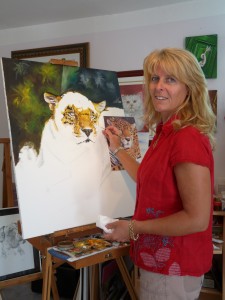 Most pets have a significant meaning in people’s lives. Their loyal companionship at times tends to excel even the presence of other humans. Indeed, many owners regard them as part of one’s family, whilst for some individuals who find themselves alone, a pet becomes the family. Pets give people joy, friendship, support and love. Ultimately their loss could prove to be quite painful.
Most pets have a significant meaning in people’s lives. Their loyal companionship at times tends to excel even the presence of other humans. Indeed, many owners regard them as part of one’s family, whilst for some individuals who find themselves alone, a pet becomes the family. Pets give people joy, friendship, support and love. Ultimately their loss could prove to be quite painful.“When my brother’s labrador died he missed it terribly and to comfort him, his partner commissioned a portrait of it. My brother was delighted with this gift and during that moment I understood the value of such work and decided instantly that one day, that would be my job.”
Quite artistic from childhood, Gaynor was further encouraged by her father when he involved her in the restoration of antique vehicles and machines.
“Around the farm where we lived in Derbyshire, England, there was an extensive stretch of land which my father allotted for a number of ancient vehicles that he intended to restore. There were all sorts of objects such as trucks, small steam trains, carousels and even an old Maltese bus. I used to help him restore their painting and this eventually led me to work as a sign-writer artist. Subsequently, my father succeeded to transform this land into a museum.”
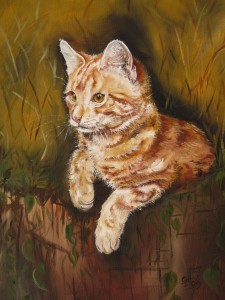 When Gaynor met her partner she had to let go of her painting since they needed to travel frequently. However in these last years they have settled in Malta and finally Gaynor found the time to fulfill her dream.
When Gaynor met her partner she had to let go of her painting since they needed to travel frequently. However in these last years they have settled in Malta and finally Gaynor found the time to fulfill her dream.“I find Malta’s picturesque scenery deeply inspiring for my artworks. Now I have my studio where I can work at my leisure and relish the feeling of being surrounded by my creations.”
Gaynor’s studio is delightful, comfortable and bright. The vision and smell of the various oil colours lying neatly at one’s reach are enticing. I found her working on the painting of a leopard. Somehow animals are her preferred subject…
“I find animals extremely fascinating to paint, much more than humans. Probably because they are so varied and beautiful. While I’m painting them I actually feel the sensation of their presence: their wet noses, their velvety long or short fur, their strong bones or their delicate structure. It’s difficult to explain… it’s a strange and lovely sentiment. Inevitably this passion was born in me during my childhood years when I lived on the farm.”
Paintings of domestic and wild animals were displayed around Gaynor’s studio. However, a painting of a boxer dog seemed to stand in a prominent spot.
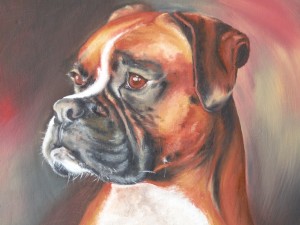 “That is my favourite painting. It shows my dog, Rocky. I missed him intensely when he passed away but when I finally completed his painting, I regained a sense of comfort since now I feel him beside me whenever I look at his image. The painting shows him exactly as I remember him: smart, proud and playful.”
“That is my favourite painting. It shows my dog, Rocky. I missed him intensely when he passed away but when I finally completed his painting, I regained a sense of comfort since now I feel him beside me whenever I look at his image. The painting shows him exactly as I remember him: smart, proud and playful.”Though a common tradition in England, pet portaiture is not characteristic in Maltese culture.
“I find this quite strange because I notice that Maltese people are very fond of their pets. Presumably it is because they are not aware of the availability of pet artists. A painting of one’s pet is a way of eternalizing its memories. It is a distinguished symbol of the deep love that can exist between humans and their animals.”
For more information Gaynor Hunt can be contacted on email gaynorhunt@live.co.uk or mobile 99809445.
(An edited version of this article was published in FIRST magazine that was issued with The Malta Independent on Sunday on 12 August 2012. A pdf version of the published feature is also available under the title PART OF THE FAMILY).
-
ICH LIEBE MALTA
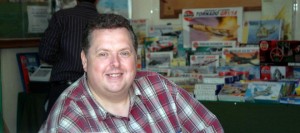 A little train set ignited a passion for model building in a young boy of three…. Now forty, Rainer Mader reveals that the same passion has kindled an intense fascination for Malta and its culture, its history and its people.
A little train set ignited a passion for model building in a young boy of three…. Now forty, Rainer Mader reveals that the same passion has kindled an intense fascination for Malta and its culture, its history and its people.“It was Christmas and my parents gave me a wonderful model train set which consisted of a black locomotive with three green passenger cars and two other red cars. These model rail sets are very popular in Germany, especially with young children who are delighted and intrigued by the movement of the trains going round on the rails. However, these train sets are also a favourite with adults too who build large landscapes through which the trains can move. Eventually it can prove to be quite an expensive hobby.”
Sitting in the cosy lounge of Preluna hotel, Rainer explained how he ended up getting hooked on this hobby of model building.
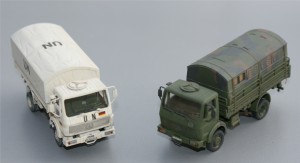 “I never stopped building models from then on, but when I joined the army, my interest turned onto military modeling. I prefer tanks, trucks and jeeps which I purchase as semi-assembled models. My finished models are around 10 cms and usually I finish them within one day. The most laborious work is the painting, as these models require to have a weathered used look and they actually need a lot of drying time.”
“I never stopped building models from then on, but when I joined the army, my interest turned onto military modeling. I prefer tanks, trucks and jeeps which I purchase as semi-assembled models. My finished models are around 10 cms and usually I finish them within one day. The most laborious work is the painting, as these models require to have a weathered used look and they actually need a lot of drying time.”Rainer admits that he has a rather impatient nature and that once he begins to work on a model, he would want to finish it as soon as possible.
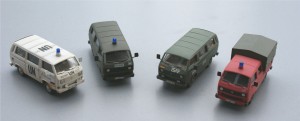 “I love this hobby because it gives me a rest from my work. Yet being very busy, I don’t have much time available to spend on a model and therefore I choose to work on semi-assembled ones. Nonetheless there are moments when I opt to convert a standard model in order to build a particular one which is not yet on the market. For example, we still have some special American trucks in Germany which are presently changing all the equipment with brand new staff. Now usually that would take about two to four years for the industry to provide an exact model of the new vehicle. So my aim would be to find a similar model of that truck and modify it accordingly in order to possess a small version of the new vehicle beforehand”.
“I love this hobby because it gives me a rest from my work. Yet being very busy, I don’t have much time available to spend on a model and therefore I choose to work on semi-assembled ones. Nonetheless there are moments when I opt to convert a standard model in order to build a particular one which is not yet on the market. For example, we still have some special American trucks in Germany which are presently changing all the equipment with brand new staff. Now usually that would take about two to four years for the industry to provide an exact model of the new vehicle. So my aim would be to find a similar model of that truck and modify it accordingly in order to possess a small version of the new vehicle beforehand”.His first glimpse of Malta back in 1999 was love at first sight…..
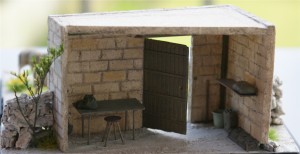 “Malta is totally different from where I live in Aschaffenburg, near Frankfurt in Germany. I remember that what impressed me most was the proximity of the sea. I love the sea… it’s beautiful crystal blue colour, it’s salty smell, and it’s ever changing sounds. It gives me a very pleasant feeling to hear it, smell it and see it everywhere around me here in Malta.”
“Malta is totally different from where I live in Aschaffenburg, near Frankfurt in Germany. I remember that what impressed me most was the proximity of the sea. I love the sea… it’s beautiful crystal blue colour, it’s salty smell, and it’s ever changing sounds. It gives me a very pleasant feeling to hear it, smell it and see it everywhere around me here in Malta.”His sister introduced him to some of her Maltese friends from Santa Venera and from then on, a long friendship was born where Rainer got to know better the Maltese people and their culture. His interest in Malta continued to grow even further once he discovered the local Association of Model Engineers and became a member there.
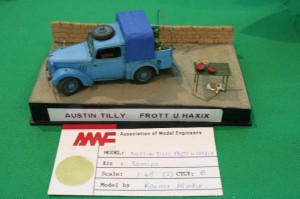 “The Association organizes an annual model exhibition and in these last five years, I have always participated with my models. Thanks to the AME I met many model enthusiasts and soon we became good friends. One can say that these exhibitions serve as a showcase of our hobby while at the same time they provide an opportunity to introduce and blend different cultures together. For example through these model exhibitions, the Maltese can experience a railway, whilst foreigners can get to know about some local customs.”
“The Association organizes an annual model exhibition and in these last five years, I have always participated with my models. Thanks to the AME I met many model enthusiasts and soon we became good friends. One can say that these exhibitions serve as a showcase of our hobby while at the same time they provide an opportunity to introduce and blend different cultures together. For example through these model exhibitions, the Maltese can experience a railway, whilst foreigners can get to know about some local customs.”In fact Rainer decided to surprise his Maltese friends by building diaromas which depict the local history and landscape.
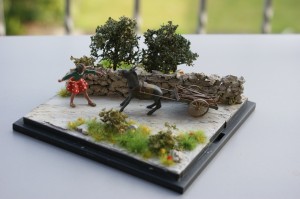 “Last year, I was flipping through the pages of a tourist magazine about Malta when I saw some old photos which instilled in me the desire to give them life through my diaromas. My first diaroma represented a van which sold vegetables and fruit. This year I made another two: one showing a woman trying to pull behind her an unwilling donkey, and another one which illustrates a sheperd with his sheep in his farm. These models were very much appreciated during the exhibition and in fact I won a gold medal”.
“Last year, I was flipping through the pages of a tourist magazine about Malta when I saw some old photos which instilled in me the desire to give them life through my diaromas. My first diaroma represented a van which sold vegetables and fruit. This year I made another two: one showing a woman trying to pull behind her an unwilling donkey, and another one which illustrates a sheperd with his sheep in his farm. These models were very much appreciated during the exhibition and in fact I won a gold medal”.Proudly Rainer showed me his dioramas while he tried to describe them in the Maltese language. Being a typical romantic Maltese, I could not help not appreciating this German’s effort to try to speak our language.
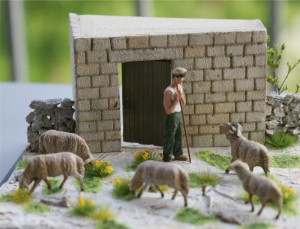 “I realized that once you start to learn some Maltese, you will increase the possibility of making friends faster. My Maltese friends simply love hearing me speak their language and many of them try to teach me some new words. In fact, a friend of mine who works as a printer, has even printed a dictionary for me with German and Maltese words and the German phonetic way to say them in Maltese. I also bought some books which include CDs of Maltese words in order to learn better the language. By now, I can only speak basic words and sentences but I am adamant to learn more. At times, I find a Maltese word which I do not understand and I ask my Maltese friends to explain to me what it means. Then, each time that I visit again, I love to surprise them with some new expressions that I learn.”
“I realized that once you start to learn some Maltese, you will increase the possibility of making friends faster. My Maltese friends simply love hearing me speak their language and many of them try to teach me some new words. In fact, a friend of mine who works as a printer, has even printed a dictionary for me with German and Maltese words and the German phonetic way to say them in Maltese. I also bought some books which include CDs of Maltese words in order to learn better the language. By now, I can only speak basic words and sentences but I am adamant to learn more. At times, I find a Maltese word which I do not understand and I ask my Maltese friends to explain to me what it means. Then, each time that I visit again, I love to surprise them with some new expressions that I learn.”Cheerfully, Rainer admitted that he is also enthralled by the local food and drink. I was quite amazed when he listed the amount of cans of Cisk and Kinnie, and packets of galletti and Twistees that he takes back with him to Germany to enjoy with his friends. Thinking about it, I thought that maybe each time that he returns back to Germany, Rainer is trying to take a little part of Malta with him.
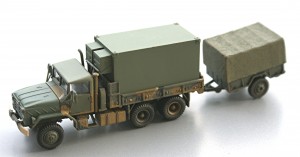 “It is true! I came to love Malta and its people very much. In fact from 2003, I visit this island each year, my visits getting more frequent each time, so that now I come to Malta three times a year. Moreover, I have a little calendar at my place of work and while I am waiting for the machines to finish, I just flip its pages and have a look. When I exhibited last year’s diorama in a German exhibition, people were very curious about it and they asked me from where I got the idea for that landscape. So I explained to them about Malta and I showed them some books about the island. Somehow these dioramas are very special to me and I won’t part with them for anything else.”
“It is true! I came to love Malta and its people very much. In fact from 2003, I visit this island each year, my visits getting more frequent each time, so that now I come to Malta three times a year. Moreover, I have a little calendar at my place of work and while I am waiting for the machines to finish, I just flip its pages and have a look. When I exhibited last year’s diorama in a German exhibition, people were very curious about it and they asked me from where I got the idea for that landscape. So I explained to them about Malta and I showed them some books about the island. Somehow these dioramas are very special to me and I won’t part with them for anything else.”Naturally Rainer is very fond of the local villages which are most near to the sea like Dingli and Xlendi. He strongly resists the idea of a bridge from Malta to Gozo because he claims that it would surely ruin the scenery. He doesn’t like the modern Maltese architecture especially the never-ending apartments which are replacing, according to him, the lovely old houses such as those that up to some years ago, used to be on the Sliema seafront. Moreover he feels perplexed about the permits of huge establishments with not enough parking space inside.
“When you visit a country so regularly, you tend to become involved more closely to it and to its people. Actually I am also very interested in the local history especially from 1940 till now, particularly the Second World War period.”
At this point, I could not help asking…. Being a German who has Malta at heart so much, how does it feel to get to know about the participation of the Germans in this war in relation to our islands?
 “Surely I am not proud of this history but no one can do anything about it; that was war and thankfully it’s history! I do feel touched when I visit the Malta at War Museum and I see those underground shelters. However though grim and painful, I need to face this history as it also gives me more background for this hobby in model making. Certainly the merging together of different cultures through such activities will help people to relate better to each other, and to establish mutual bonding and respect that will prevent history from ever repeating itself.”
“Surely I am not proud of this history but no one can do anything about it; that was war and thankfully it’s history! I do feel touched when I visit the Malta at War Museum and I see those underground shelters. However though grim and painful, I need to face this history as it also gives me more background for this hobby in model making. Certainly the merging together of different cultures through such activities will help people to relate better to each other, and to establish mutual bonding and respect that will prevent history from ever repeating itself.”Rainer gave me the impression that by now his life is divided between two countries. In fact, he came to celebrate his 40th birthday with a very long holiday among his Maltese friends. Curiously I asked him whether he would ever consider to come and live for good in Malta?
“Għalissa għadha ħolma…. For now it’s only a dream. But probably, when I’ll come to retire from work, this possibility will be very much on my mind. Presently I can only foretell my next visit to Malta in October wherein I intend to present some new dioramas. But that is all I can say… the rest is a secret!”
(Note: An edited version of this article was published on FIRST magazine Issue June 2012).
-
MINIATURE CHURCH DEVOTION – pdf version
 When it comes to our churches, we Maltese are famous for generally thinking that bigger is better. I discovered that the same reasoning prevails among a group of dedicated enthusiasts who build models of local churches, maintaining a tradition handed down from the time of the Knights, and including one who was recognised with an entry in the Guinness Book of World Records.
When it comes to our churches, we Maltese are famous for generally thinking that bigger is better. I discovered that the same reasoning prevails among a group of dedicated enthusiasts who build models of local churches, maintaining a tradition handed down from the time of the Knights, and including one who was recognised with an entry in the Guinness Book of World Records.Read the full feature which was published in FIRST magazine – April 2012 …
-
MINIATURE CHURCH DEVOTION
As several bombs were let loose on our islands during the attacks of World War II, their destructive effects threatened more than human lives and buildings. They put at peril our heritage, jeopardizing the roots of our people and the future of our country.
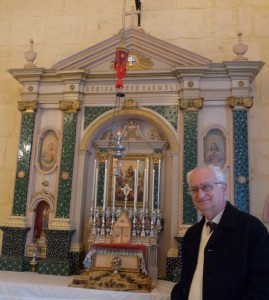 Raphael Micallef, now 82, still recalls the terror felt by the people as the shrill of the air-raid sirens urged them to leave their houses and run for shelters. As an inhabitant of the capital city, he saw his town being shattered to pieces, the damage claiming even unique treasures such as the Chapel of Bones which used to be so popular both with the locals and the tourists. People huddled together in shelters and prayed for their own safety but they also implored for their houses to be spared as these nested within them all their possessions, memories of loved ones, and valuable objects which had been passed on from generation to generation.
Raphael Micallef, now 82, still recalls the terror felt by the people as the shrill of the air-raid sirens urged them to leave their houses and run for shelters. As an inhabitant of the capital city, he saw his town being shattered to pieces, the damage claiming even unique treasures such as the Chapel of Bones which used to be so popular both with the locals and the tourists. People huddled together in shelters and prayed for their own safety but they also implored for their houses to be spared as these nested within them all their possessions, memories of loved ones, and valuable objects which had been passed on from generation to generation.“Valletta and Cottonera suffered some of the severest attacks. Unfortunately within these areas one could find the best examples of church models, many of which had been inherited over many years. Sadly most of them had to be abandoned during the war and almost all of them ended up buried under the rubble of destroyed buildings.”
The craft of church model-making had been introduced to our islands by the Knights of St John back in the 16th century, and therefore it’s knowledge was a distinct tradition. However the adversity of war ravaged even this ancient memory until eventually this craft was almost completely forgotten.
In 1986, this dire situation inspired Raphael, who was an avid enthusiast in church model-making, to make an effort to revive this craft. Together with his friends Tony Terribile and Paul Piscopo, he ventured to initiate an association under the name of Għaqda Dilettanti Mudelli ta’ Knejjes which aimed to instill interest, knowhow and craftsmanship in the art of church model-making. The first president of the association was Guido Lanfranco.
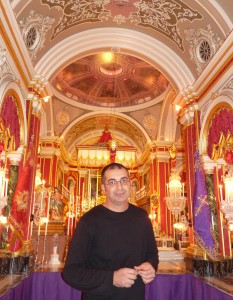 “After 26 years, I am proud to say that now we have our own premises at 37 East Street, Valletta. Although it is a small place, our 400 members meet keenly under its humble roof in order to attend to the regular activities that we organize. Members’ ages differ greatly; starting from young children of 7 and going up to elderly individuals over 90. Everybody is welcome in our group and together we learn and discuss new ideas of how to enrich this cultural tradition. Each of the members has the opportunity to explore his skills and to enhance them further both through the interaction with other members and also under the guidance of craftsmen and historians who are frequently invited to our premises. Many members have built their own church models, some of which one can even walk through – a popular model is that of Simon Mercieca which is often open to the public for viewing. Others have opted to produce statues and accessories which are used in the church models. Most of the members succeed in producing marvellous works, sometimes using common objects and transforming them into intricate decorations which adorne the models.”
“After 26 years, I am proud to say that now we have our own premises at 37 East Street, Valletta. Although it is a small place, our 400 members meet keenly under its humble roof in order to attend to the regular activities that we organize. Members’ ages differ greatly; starting from young children of 7 and going up to elderly individuals over 90. Everybody is welcome in our group and together we learn and discuss new ideas of how to enrich this cultural tradition. Each of the members has the opportunity to explore his skills and to enhance them further both through the interaction with other members and also under the guidance of craftsmen and historians who are frequently invited to our premises. Many members have built their own church models, some of which one can even walk through – a popular model is that of Simon Mercieca which is often open to the public for viewing. Others have opted to produce statues and accessories which are used in the church models. Most of the members succeed in producing marvellous works, sometimes using common objects and transforming them into intricate decorations which adorne the models.”Each year, during the Lenten period, the association organizes an exhibition with some of the works of the members, both to give them the opportunity to share their skill with others and also to attract the public to this old tradition.
“Our association is deeply cherished by its members. In fact some of them have honoured us by donating us prestigious works which belonged to them or to their families. It is a great privilege to possess a number of the few lucky survivors of war which managed to make it, as their owners lovingly took them along with them to safer areas.”
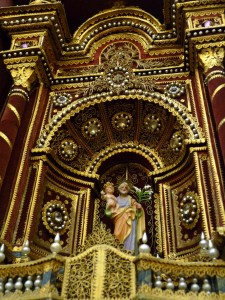 Raphael showed me some of these examples, including an elegant limestone church facade which was designed by Manuel Psaila between 1935 and 1940, and a delicate niche produced out of quilling which dates back to more than 100 years. I was thankful to Raphael for having shared with me this experience. His calm and serene smile was full of pride as his dream of giving the life back to a part of our culture was fulfilled. In fact the association’s work has succeeded to reach much further grounds than any of the members could ever have aspired for, when in 1994, Joseph Sciberras ended up winning a place in the Guinness Book of Records for his church model which was made out of more than 3 million used up matchsticks!
Raphael showed me some of these examples, including an elegant limestone church facade which was designed by Manuel Psaila between 1935 and 1940, and a delicate niche produced out of quilling which dates back to more than 100 years. I was thankful to Raphael for having shared with me this experience. His calm and serene smile was full of pride as his dream of giving the life back to a part of our culture was fulfilled. In fact the association’s work has succeeded to reach much further grounds than any of the members could ever have aspired for, when in 1994, Joseph Sciberras ended up winning a place in the Guinness Book of Records for his church model which was made out of more than 3 million used up matchsticks!I met Joseph Sciberras, now 93, in his son’s home in Attard. Sitting cosily near his bird pet who sung cheerfully at his side, Joseph told me the story of his model which has given him so much satisfaction in his life.
“I was an electrician by trade but during the war I was engaged as a soldier. I remember vividly a particular day when I was at work in Delimara and came to know that Floriana, where I lived, had just been badly hit by bomb attacks. I was desperate to see whether my family was safe and whether our house was damaged, and my superior allowed me to leave. I walked right back to Floriana there and then, and luckily both my family and my house were safe. The enemy used to target his attacks from the Floriana parish church and bomb throughout. We lived nearby and one day our house did fall victim to these attacks, alas like the church which did too anyway.
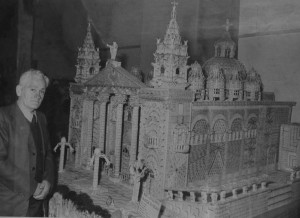 Years passed and both our houses and the Floriana parish church were rebuilt. I used to like to observe the facade of our beloved church and when I became a pensioner, I decided to start building an exact model of it. I chose to construct it out of used up matchsticks. Day after day, I worked on my model, constantly taking measures and designing the acute details of the facade.
Years passed and both our houses and the Floriana parish church were rebuilt. I used to like to observe the facade of our beloved church and when I became a pensioner, I decided to start building an exact model of it. I chose to construct it out of used up matchsticks. Day after day, I worked on my model, constantly taking measures and designing the acute details of the facade.When my friends who most of them worked at the Dockyards got to know what I was doing, they started to collect used mathsticks for me. Then when I exhibited my first model to the public, these matchsticks began to arrive from different areas of Malta! I had so many in hand that I ended up doing all the parish church inside out, until eventually the model measured 2 metres by 2 metres with a height of a further 1.5 metres.
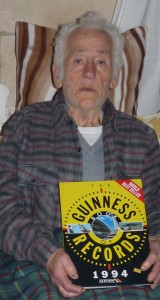 People were totally mesmerized by my model and many, including several tourists, even hugged me when they noticed all the details and work that I had put into my work. It was during one of these exhibitions when some foreigners entered to view my model. I could not be more lucky as these were officials of the Guinness Book of Records and as they studied and measured my model, they informed me that I had succeeded to break the record of the previous winner matchstick model! Soon a certificate arrived together with my inclusion in the Guinness Book of Records.” Spiritedly Joseph showed me his model church displayed on the pages of this famous book. He felt very satisfied that his hard work which took so many years to do was given such an acknowledgement.
People were totally mesmerized by my model and many, including several tourists, even hugged me when they noticed all the details and work that I had put into my work. It was during one of these exhibitions when some foreigners entered to view my model. I could not be more lucky as these were officials of the Guinness Book of Records and as they studied and measured my model, they informed me that I had succeeded to break the record of the previous winner matchstick model! Soon a certificate arrived together with my inclusion in the Guinness Book of Records.” Spiritedly Joseph showed me his model church displayed on the pages of this famous book. He felt very satisfied that his hard work which took so many years to do was given such an acknowledgement.“Ultimately this model became part of my life as I have dedicated much of my love and my time to it. In return it gave me happinness as I saw people admiring it and appreciating my skill and patience. I have taken good care of it all along these years and my final wish is to donate my model to our National Museum of Etnography wherein it could be enjoyed by the public in reminiscence of me and of this ancient cultural tradition. I feel sad to leave it behind me but one cannot live forever, can he?”
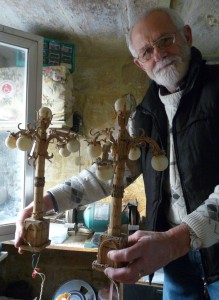 I could not resist the invitation of Francis, Joseph’s son, to visit the workshop of his father in Floriana wherein this model was stored. Humorously Francis indicated the name of the place “Sulfarina” (matchstick). “Interestingly our family was originally known as “Taċ-Ċomb” (of lead) but today, because of my father’s model, everyone knows us as “Tas-Sulfarini” (of the matchsticks). Notwithstanding that my father has stopped working now, I still find packets full of used matchsticks which people leave behind his door.”
I could not resist the invitation of Francis, Joseph’s son, to visit the workshop of his father in Floriana wherein this model was stored. Humorously Francis indicated the name of the place “Sulfarina” (matchstick). “Interestingly our family was originally known as “Taċ-Ċomb” (of lead) but today, because of my father’s model, everyone knows us as “Tas-Sulfarini” (of the matchsticks). Notwithstanding that my father has stopped working now, I still find packets full of used matchsticks which people leave behind his door.”We went into the small building which was totally engulfed by the huge model of the Floriana parish church and by other of Joseph’s works, all made of matchsticks. With some difficulty, Francis managed to find his way through the multitude of wires which his father had included in the model in order to light up the church.
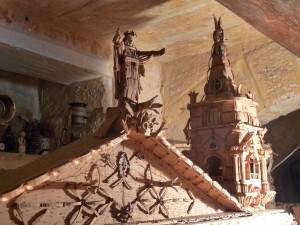 Now I could observe what Joseph had talked about…. the millions of matchsticks, each one placed or thwarted to fit into the shape that he had designed for them…. the facade, the dome, the walls, the columns, the niches, the floor, the minute chairs. There were also small silver apostles which Francis had made for his father to place on the altar. Miniature gorgeous chandeliers made up of common scrap hung beautifully along the flowing arches. It was all set up and ready as if inviting people to go inside.
Now I could observe what Joseph had talked about…. the millions of matchsticks, each one placed or thwarted to fit into the shape that he had designed for them…. the facade, the dome, the walls, the columns, the niches, the floor, the minute chairs. There were also small silver apostles which Francis had made for his father to place on the altar. Miniature gorgeous chandeliers made up of common scrap hung beautifully along the flowing arches. It was all set up and ready as if inviting people to go inside.I gazed inside the model church, my eyes resting and enjoying every detail whilst I slowly understood what this all means… Within this modest model lied the admirable representation of our local skills together with the ability of our people to prevail even through the hardest times.
For further information about the Għaqda Dilettanti Mudelli ta’ Knejjes, one can access their website www.freewebs.com/ghaqda_dilettanti_knejjes or join their facebook page.
(Note: An edited version of this article was published in FIRST magazine Issue April 2012. A pdf version of the published article is available on this website under the title MINIATURE CHURCH DEVOTION).
-
CHRISTMAS EGGS
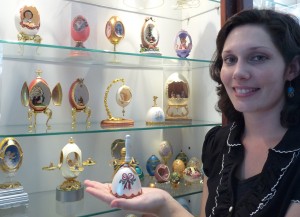 Natives watched eagerly with awe as the foreign traders unwrapped large ostrich eggs decorated with exotic painted designs. The Phoenician merchants were sure that the ornamented eggs will be sold out in a matter of minutes, for this race possessed the key to humanity’s heart – the ability to manipulate a sense of wonder. Centuries later this magic still lives … an ingenious craft which started far away in an Australian farm has recently been introduced to our islands by Candice Fava, whose artistry in egg decoration is a joy to behold.
Natives watched eagerly with awe as the foreign traders unwrapped large ostrich eggs decorated with exotic painted designs. The Phoenician merchants were sure that the ornamented eggs will be sold out in a matter of minutes, for this race possessed the key to humanity’s heart – the ability to manipulate a sense of wonder. Centuries later this magic still lives … an ingenious craft which started far away in an Australian farm has recently been introduced to our islands by Candice Fava, whose artistry in egg decoration is a joy to behold.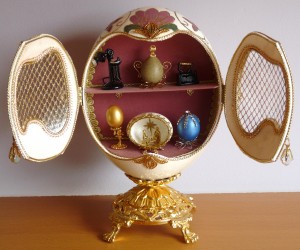 “I have fond memories of my childhood. My family lived in a farm in Australia from which we used to sell eggs. We had lots of clients but one particular client attracted my attention since she regularly purchased a substantial quantity of eggs. One day I decided to ask her why she always needed so many eggs and she promised that the next time she called at our farm, she will bring me a gift to show me. I felt deeply curious and I awaited her next visit with much anticipation. When she came she brought me a little jewel box adorned with lovely fabrics and accessories. I could not believe that she had actually made it with one of the eggs from our farm! It was such a fascinating idea that I made up my mind to learn this craft. I was blessed to have so much eggs to experiment upon and my mum urged me and gave me ideas to be creative. Eventually I succeeded to learn how to empty the eggs and clean them thoroughly without breaking them. The first item I made was a jewel box which I painted with a bright nail polish. I was so delighted when I saw it ready! Today I realize that it wasn’t much and I keep it hidden away. However it is very dear to me as it reminds me from where it all started.”
“I have fond memories of my childhood. My family lived in a farm in Australia from which we used to sell eggs. We had lots of clients but one particular client attracted my attention since she regularly purchased a substantial quantity of eggs. One day I decided to ask her why she always needed so many eggs and she promised that the next time she called at our farm, she will bring me a gift to show me. I felt deeply curious and I awaited her next visit with much anticipation. When she came she brought me a little jewel box adorned with lovely fabrics and accessories. I could not believe that she had actually made it with one of the eggs from our farm! It was such a fascinating idea that I made up my mind to learn this craft. I was blessed to have so much eggs to experiment upon and my mum urged me and gave me ideas to be creative. Eventually I succeeded to learn how to empty the eggs and clean them thoroughly without breaking them. The first item I made was a jewel box which I painted with a bright nail polish. I was so delighted when I saw it ready! Today I realize that it wasn’t much and I keep it hidden away. However it is very dear to me as it reminds me from where it all started.”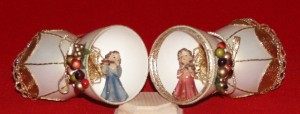 Looking at the variety of decorated eggs in her shop NewEggsperience in Żabbar, it was clear that Candice had learned the craft quite well. I surely found it hard to understand how she could carve out doors, windows, shelves and other designs from a simple egg-shell. And like the famous incredulous St Thomas, she had to allow me to hold an object in my hands in order to affirm that it was really made out of an egg.
Looking at the variety of decorated eggs in her shop NewEggsperience in Żabbar, it was clear that Candice had learned the craft quite well. I surely found it hard to understand how she could carve out doors, windows, shelves and other designs from a simple egg-shell. And like the famous incredulous St Thomas, she had to allow me to hold an object in my hands in order to affirm that it was really made out of an egg.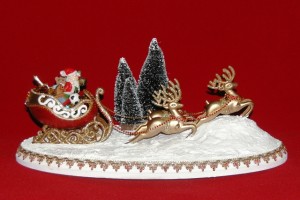 “People everywhere react in this way with regards to these items since most think that eggshell is too fragile to work with. However the eggs which I use today are provided by foreign farms who specialize in this sector where probably the birds are given food mixed with fragmented shells in order to harden the quality of their eggshells. This craft is so widespread in different countries that there are also factories which sell a variety of cleansed eggs.”
“People everywhere react in this way with regards to these items since most think that eggshell is too fragile to work with. However the eggs which I use today are provided by foreign farms who specialize in this sector where probably the birds are given food mixed with fragmented shells in order to harden the quality of their eggshells. This craft is so widespread in different countries that there are also factories which sell a variety of cleansed eggs.”Yet when Candice came over to Malta, she was quite shocked as there were no shops who sold the accessories needed for this work.
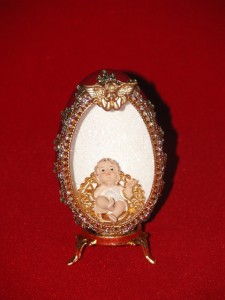 “This craft was totally unknown in Malta but with the help of my husband I searched on the internet and I succeeded to buy all that was necessary online. Egg decoration had become an essential part of my life and I simply could not stop creating new things. Initially I did these objects for my personal satisfaction. Then surprisingly, when I started to give them out as gifts, I began to receive requests from my friends to make something for them. Eventually I had so many finished objects and I saw so much interest in my work, that I decided to fulfill another dream of mine and I opened this shop.”
“This craft was totally unknown in Malta but with the help of my husband I searched on the internet and I succeeded to buy all that was necessary online. Egg decoration had become an essential part of my life and I simply could not stop creating new things. Initially I did these objects for my personal satisfaction. Then surprisingly, when I started to give them out as gifts, I began to receive requests from my friends to make something for them. Eventually I had so many finished objects and I saw so much interest in my work, that I decided to fulfill another dream of mine and I opened this shop.”A range of eggs of various sizes and colours were ready to be transformed into new creations. Likewise, small jars of colourful paint and a multitude of various decorations were crying out to become part of a new charming object.
“I’m always dreaming of what I can do next. I work with all sorts of eggs, starting with the smallest ones of love-birds and parrots, and moving on to larger ones such as those of pigeons, quails, ducks, geese, emu, rhea and ostrich. The geese’ eggs are the most practical because of their size and shape. Other eggs are relished for their natural particular characteristics such as the blackish colour of the rhea eggs and the large shape and pearly shade of the ostrich eggs.”
For the Christmas season, Candice has come up with exquisite original creations.
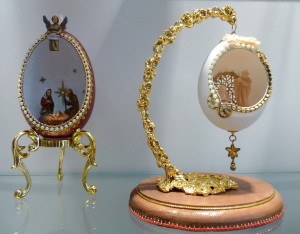 “Christmas time is wonderful and I love to reflect its warm sensations and meaning in my works. Cribs are the most requested although I have a vast selection of other items too. I’m constantly pondering over new creations as I thrive hard to provide unique hand-made objects which one could give to that special person who deserves such an exclusive gift.
“Christmas time is wonderful and I love to reflect its warm sensations and meaning in my works. Cribs are the most requested although I have a vast selection of other items too. I’m constantly pondering over new creations as I thrive hard to provide unique hand-made objects which one could give to that special person who deserves such an exclusive gift.Some clients have even asked me to show them how these creations are done in order to be able to produce them for themselves and also to compose their very own personal gift this Christmas. I instructed them how to do Christmas crackers first and many clients were delighted to see that even they could produce beautiful objects. For after all, it’s all a matter of creativity, dedication and much patience.”
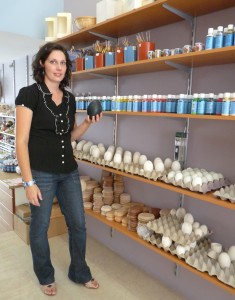 I asked her whether she was worried that these very clients would one day become her very competitors.
I asked her whether she was worried that these very clients would one day become her very competitors.“Probably some of them might but I have no problem with that. Instead I feel great satisfaction when I understand that I succeeded to initiate the love for this craft in these islands. For after all what is the value of such creativity if you can’t share it with others?”
(Note: An edited version of this article was published in FIRST Issue December 2011)
-
THE SKIN GAME
I was calmly reading Barbara Streisand’s biography while waiting in a surgeon’s clinic. A few days before, I had undergone a biopsy to remove a mole which in the last months had seemingly cropped out of nowhere on my skin. On that day I was to meet the surgeon to get feedback about it. I wasn’t worried at all. I was sure that there was nothing wrong with the mole as I felt completely healthy. Ironically I was actually irritated for spending more money on such futile tests! Little did I know what was waiting for me. Nothing ever changed my life that much…
My surgeon greeted me warmly and then slowly but quite directly, he told me that the results of the mole removed were positive. Ah, good then, I thought. Positive is ok, no? But my surgeon shook his head. The results were positive on the reporting of a malignant mole. It was a Melanoma case. In short – I had cancer! I was surprised by the result and could not quite get it. For a brief moment I thought that my surgeon was playing a nasty joke on me to see how I would react to such news. Playfully I even asked him whether I should start saying goodbye to all the people I knew before I got buried? But he did not laugh and instead he started to inform me about the procedures which would follow, whilst reassuring me that I will be in good hands. I left the clinic still quite incredulous. It was the silence that followed as soon as I phoned my husband to tell him the news that finally burned the dire reality in my mind.
I drove home as if in a dream. I had never ever thought of ending up in this way. I was shocked at how life can change within a few minutes. I was only 37 and definitely not ready to die at all. I thought of my daughter who was only six and of my husband. Then my parents came to my mind and I felt deeply concerned about the consequences of such news upon them. My relatives and friends followed and then the people I had loved and those who had loved me. My life ran fast in my mind as if I was watching a film. I arrived home and my daughter came running happily to hug me as she always does. In the background I could see my husband looking at me thoughtfully. How could I leave all this behind me? How could I tell to such a young child that she could lose her mother in a short time?
Thankfully this matter was followed up promptly by another small operation in which this time, the immediate flesh that surrounded the area where the mole had appeared, was removed. The cancer had not penetrated much into the skin and therefore that was all physically, except that I had to attend to regular follow ups with my doctor and obviously I had to ensure not to expose myself too much to the sun and to apply protective sunscreens.
However psychologically I was badly shaken. I had decided not to tell anyone about my Melanoma until I did the operation and the results proved that I was out of danger… although you never actually have this guarantee. But in this way, I relieved my relatives of all the stress that was involved until the results were issued. There were only a few days of waiting but all along them I felt distraught. It was as if my world had stopped moving and instead I was completely focused on myself. How was I going to survive this? What could I do to help myself? Maybe there was nothing that I could do but pray. I had been noticing and ignoring the appearance of this strange dark mole for months now and I was not sure how much harm I had allowed myself to get into. Warnings of the Health Department kept nagging at my mind but strangely there were always other things which I deemed more important to take care of and I kept postponing in referring this matter to a doctor until one day I found the time.
Actually, on looking back at my life I realized that I had a regular tendency to ignore my self. I had moved from one job to another without ever doing what I really wanted – to study archaeology. I had stopped writing novels because I never ever found time. Moreover I had for long tried to smother the love I felt for drama because those around me never approved. In a nutshell, I never gave myself the time to do what my soul really craved for. This recognition began to eat me up in despair. I promised myself that if I succeeded to surpass this incident, my life would change. I would never ignore myself anymore!
Fortunately another chance was in store for me and I surely kept my word. In a few months’ time I managed to introduce my writing to Aleks Farrugia, the Torċa editor, and he allocated me a weekly two-page article in his newspaper. Moreover, I attended to drama workshops and subsequently I was entrusted with a number of roles in various TV productions. I finally allowed myself to study the subjects I yearned for so much and this year I started a BA in Archaeology and Anthropology.
I must admit that I am finally really living and not simply existing. Ironically it had to be a close brush with death to set me in motion. I am grateful that I was allowed another chance, knowing that not everybody is so lucky. An adequate health insurance was providential to cover such an urgent matter. Moreover I owe my life to our professional local surgeons and to the Health Authorities who constantly warn and inform us about how to protect ourselves from the sun’s rays and how to recognize any suspicious moles and symptoms. Finally I am adamant to use this experience to safeguard others from this potential risk. I want to ensure that this second chance saved much more than one life…
Interview with Dr Charmaine Gauci – Director, Health Promotion and Disease Prevention Directorate.
What is Melanoma and how is it caused?
Melanoma is a skin cancer caused by unprotected exposure to UV rays. It forms within melanocite cells which are found within the skin to give it pigmentation. When these cells are excessively exposed to the sun, they start to change shape and to multiply whilst also becoming cancerous. Unfortunately Melanoma cases are increasing because of two main factors: the depletion of the ozone layer and a new lifestyle resulting in spending more time near the sea under the sun’s rays.
What are the symptoms of Melanoma?
In the beginning an individual feels perfectly healthy. It is only when the cancer grows deeper that some symptoms are perceived due to metastesis. At this point, the cancer would prove more difficult to cure. It cannot be stressed enough how crucial it is that if one identifies a suspicious mole, one must immediately refer it to a doctor. If recognized in an early phase, a Melanoma can be cured in a short time. However, if ignored, Melanoma could be fatal.
How do you recognize a malignant mole?
ABCDE Leaflet 2011 – melanoma Regular self-examination is the best way to get familiar with the moles on your skin. Tricky areas such as the feet soles should not be forgotten. Moreover, a family member or a friend can help you check areas which you cannot see yourself, such as the back, the scalp and the mouth. For the identifying of malignant moles, the ABCDE rule is recommended:
Asymmetry: when a mole is not symmetrical;
Border: when a mole’s border is irregular;
Colour: when there is different colour pigmentation in same mole;
Diameter: when a mole reaches around 6mm (although there are also smaller moles which are malignant);
Evolution: if a mole starts changing shape, size, colour or if blood comes out of it. Moreover, a mole which appears late in life should always be given attention.
How is Melanoma cured?
In case of an early identification, a biopsy and an excision will remove the cancerous area. If the cancer has already spread in the skin, other methods such as chemo-therapy and radio-therapy are used. Eventually each case is treated according to that particular situation.
What are the recommended precautions to decrease the risk of Melanoma?
One should definitely avoid exposure to UV rays during the severest hours of the sun, that is from 11:00am to 4:00pm. Even in cloudy weather UV rays are still dangerous. Umbrellas give some measure of protection but never enough. Sunscreen creams/sprays are a must but they should not be considered as sun-blocks because no product actually stops the sun’s rays from penetrating the skin. When choosing a sunscreen cream/spray, a high factor is recommended. Re-application every two to three hours is suggested especially if one has gone for a swim. Light clothing, hats and sun glasses are further protective measures.
I would like to emphasize that these harmful rays are not only existant near the sea. UV rays are found everywhere and therefore for example a housewife should avoid washing the clothes on the roof during these hours. The same is suggested to workers who’s work is outside like technicians and salesmen.
From which grade are UV rays dangerous?
From 3 – 4, one should start taking precautions. From 5 – 6, UV rays are moderate but one must apply a sunscreen. At more than grade 6, UV rays are extremely harmful.
What is the probability of re-emergence of Melanoma in an individual who has already been cured of it?
These individuals will have a greater pre-disposition to the effects of Melanoma and therefore they should take stricter precautions.
How much has this condition spread in our country? Have there been any fatalities in Malta due to Melanoma?
New Cases in Malta: 1999 – 2008 Males 163 and Females 196
Deaths attributed to malignant cutaneous Melanoma: 1999 – 2009 Males 43 and Females 27
Our directorate works in different settings including schools, workplaces and the community. Anyone who would like to organize a health promotion program can contact us on tel: 2326 6789 or email: charmaine.gauci@gov.mt. More information is available on our website: http://www.sahha.gov.mt.
(Note: An edited version of this article was published on FIRST Issue July 2011)
Travelogue
Archives
| M | T | W | T | F | S | S |
|---|---|---|---|---|---|---|
| « Jan | ||||||
| 1 | 2 | 3 | 4 | 5 | 6 | 7 |
| 8 | 9 | 10 | 11 | 12 | 13 | 14 |
| 15 | 16 | 17 | 18 | 19 | 20 | 21 |
| 22 | 23 | 24 | 25 | 26 | 27 | 28 |
| 29 | 30 | 31 | ||||
Recent Posts
- A MATTER OF FATE
- MALTA’S PREHISTORIC TREASURES
- THE MAGIC IS IN THE DETAIL
- THE SELLING GAME
- NEVER FORGOTTEN
- Ġrajjiet mhux mitmuma – 35 sena mit-Traġedja tal-Patrol Boat C23
- AN UNEXPECTED VISIT
- THE SISTERS OF THE CRIB
Comments
- Pauline Harkins on Novella – Li kieku stajt!
- admin on IL-KARNIVAL TRAĠIKU TAL-1823
- Albert on IL-KARNIVAL TRAĠIKU TAL-1823
- Martin Ratcliffe on Love in the time of war
- admin on 24 SENA ILU: IT-TRAĠEDJA TAL-PATROL BOAT C23
